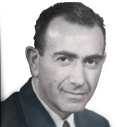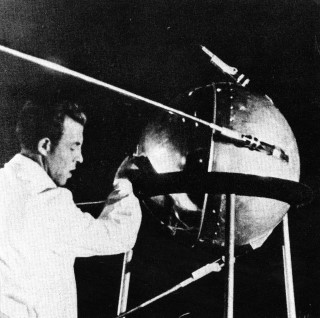Sputnik Satellite: The Sputnik 1 satellite, shown here on a rigging truck in the assembly shop, was successfully launched and entered Earth's orbit on October 4, 1957. Sputnik shocked the world, giving the Soviet Union the distinction of sending the first human-made object into space and placing the United States a step behind in the space race.
Credit: NASA
The Sputnik launch in 1957 was a shocker. We had been meeting all week with the Russians at the National Academy, in which we were describing our respective rocket programs, Sputnik and Vanguard. During the discussions we had the sense that we were ready to launch and they were not, and yet they were giving us signals that we just didn’t appreciate. By the end of the week of that meeting, the news came that the Russians had succeeded in launching Sputnik, and it really took us completely by surprise.
The following year I went to Moscow for some meetings. The Russians had an exhibit at their Industrial Fair in which they showed Sputnik 1 and Sputnik 2 and the instrumentation that went into them. It surprised all of us who were there to actually see this because back home we were just guessing: What kind of technology did they have? And how had they put it all together? And there it was, spread out right before our eyes. One of the components in Sputnik 2 was a Geiger counter.
Before I left Russia I visited a science supply store, and in the store window was the counter that I had seen in Sputnik 2! I was there with John Simpson of the University of Chicago. We each bought a counter at something like a ruble a piece. I wondered, Will they let us take these out of the country? So at the airport I stuck the counters in my coat pocket like two cigars, and I just walked through. It worked! The Russians were very relaxed at that time, and they didn't frisk us. After I got back to the U.S., one of our intelligence people came in to talk to me. I had the counter on the table, and I casually mentioned that this was the Sputnik counter. He was shocked! Then he asked to borrow the counter, with promises to return it undamaged and so on. Months later the counter came back to us, now as a classified secret.
Project Vanguard: Between 1955 and 1959, NRL conducted the first American satellite program, named Project Vanguard. On March 17, 1958, the Vanguard I satellite was successfully launched into Earth orbit. Just 6 inches (152 mm) in diameter and weighing 3 pounds (1.4 kg), Vanguard 1 was described by then-Soviet Premier Nikita Khrushchev as, "The grapefruit satellite." Here NRL scientists from the Vanguard I team mount the satellite in the rocket. Vanguard 1 is the oldest artificial satellite still in space, as its predecessors, Sputnik 1, Sputnik 2, and Explorer 1, have fallen out of orbit.
Credit: Naval Research Laboratory



